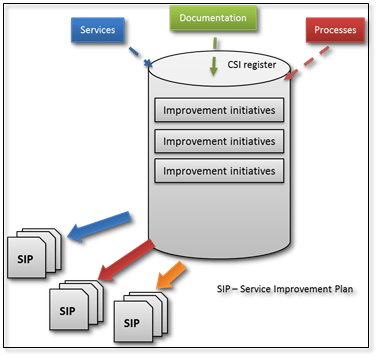One of the consequences of the progress in technology and applications development is that services are gaining in complexity. So is IT Service Management.
IT Service Management (according to ITIL) encompasses altogether 26 processes and 4 functions. There are a lot of companies that practice many of the processes, i.e., functions. And this involves a lot of people. Many of them have an idea of how to improve things they are dealing with. Those “things” could be a service (or some part of it), a process, training, documentation… etc.
Now, can you imagine the mess that would be caused if everyone who has an idea of how to improve something would start implementing whatever he finds appropriate? There would be many improvement initiatives running in parallel. The situation would become just like the traffic in a big city without traffic signs.
How do you manage improvement initiatives?
Make them formal. All improvement initiatives should be recorded in the Continual Service Improvement (CSI) register. That’s the database with improvement opportunities. From there, a Service Improvement Plan (SIP), whichis a formal plan for improvement, should be created. This is your tool to manage improvement initiatives. As the name implies (i.e., a plan) – it contains all relevant information for a particular improvement initiative. The format of the plan is up to you. If it suits your needs – it could be a single document. As long as it contains all relevant information for a particular improvement initiative, it’s fine – i.e., as long as the owner of the initiative has all that he needs to manage it.
Although it sounds simple (i.e., someone has a good idea of what – and how – to improve), it really isn’t. So, let’s start one. There are several parameters that need to be considered:
Responsibility. The CSI Manager is responsible for the success of all improvement activities. He is the one who works together with process managers, service owners, or functions to identify opportunities for improvement, build SIPs, and make improvements. Working together with service owners, i.e., process managers is essential, because they are knowledgeable about services and processes.
Budgeting. When budgeting takes place (do you remember – one of the activities in the Financial Management process?), a certain amount of money should be planned for improvement activities. Let’s call this the easy part. The complicated part is when initiatives come through the Service Level Management or Business Relationship Management process, i.e., processes that are in direct contact with customers and that can anticipate where improvements are necessary (which, further on, lead to increased customer satisfaction or value created with the service). This can hardly be predicted, and the solution usually requires compromise with some other plans or confirmation of unplanned costs.
Processes throughout the service lifecycle. Almost every process in the service lifecycle can be a source of improvement initiatives. The CSI Manager should encourage all process managers to actively participate in CSI. Ideally, the CSI Manager will be someone’s job description, i.e., there will be a person dedicated only to this role. Sure, smaller organizations can’t afford that. But, bigger IT organizations can do that. This way they will have a proactive approach toward service improvements, and it is to be expected that such person’s costs should be covered with the savings (or revenue increase) that result from the improvement activities.

Where do the improvement initiatives come from, anyway?
I already mentioned that processes that are in direct contact with customers are excellent sources of improvement initiatives. Here I mean Service Level Management (on an operational level) and Business Relationship Management (on a business level). They know their own services and the organization behind them, but also they get feedback about the customer’s perception of services and their expectations. The customer’s view of your services is crucial. You can think that your services are the best, but it’s important what customers think about them. If there is anything you can do better – an improvement initiative should be created and implemented.
Many processes and even lifecycle stages are related. Take, e.g., the Service Design and Service Transition stage of the service lifecycle. The Service Design Package is a “product” of Service Design and the trigger for Service Transition. This means, when building and testing begin in the Release and Deployment process (part of Service Transition), all potential improvement on the design of the service will be detected. The same is valid when the service enters the operation phase (i.e., Service Operation). Early life support will detect all deficiencies originated in Service Transition. The SIP should involve all relevant parties and process owners with the goal to implement improvement so that errors don’t appear in future services.
Major Incidents and/or Major Problems require review. This review will analyze what happened, why it happened, and what to do to prevent repetition. And – there is input for improvement initiatives which could lead to the SIP.
For the benefit of all
I often witness improvement initiatives that could best be described as “an island in the middle of the ocean,” i.e., there are no coordinated activities, prioritization, and evaluation of made improvements. The CSI register and SIP give a solid foundation, showing that there is improvement in the scope of the Continual Service Improvement stage of the service lifecycle. And this is good, because no one or nothing should be immune and excused from improvements. It could be always better, couldn’t it?
To implement ISO 20000 easily and efficiently, use our ISO 20000 Documentation Toolkit that provides step-by-step guidance for full ISO 20000 compliance.

 Neven Zitek
Neven Zitek 


